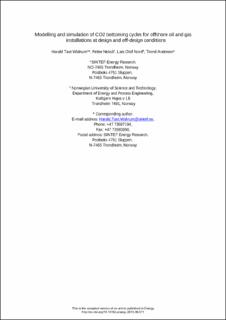| dc.contributor.author | Walnum, Harald Taxt | |
| dc.contributor.author | Nekså, Petter | |
| dc.contributor.author | Nord, Lars Olof | |
| dc.contributor.author | Andresen, Trond | |
| dc.date.accessioned | 2021-10-01T11:03:08Z | |
| dc.date.available | 2021-10-01T11:03:08Z | |
| dc.date.created | 2013-09-02T12:23:46Z | |
| dc.date.issued | 2013 | |
| dc.identifier.citation | Energy. 2013, 59 513-520. | en_US |
| dc.identifier.issn | 0360-5442 | |
| dc.identifier.uri | https://hdl.handle.net/11250/2786970 | |
| dc.description.abstract | Improved energy efficiency is an issue of increasing importance in offshore oil and gas installations. The power on offshore installations is generated by gas turbines operating in a simple cycle. There is an obvious possibility for heat recovery for further power generation from the exhaust heat. However, the limited space and weight available makes the inclusion of bottoming cycles challenging. Due to its high working pressure and thereby compact components CO2 (carbon dioxide) could be a viable solution, combining compactness and efficiency. An in-house simulation tool is used to evaluate the performance of CO2 bottoming cycles at design and off-design conditions. Both a simple recuperated single stage cycle and a more advanced dual stage system are modelled. Results from simulations show a potential for 10-11%-points increase in net plant efficiency at 100% gas turbine load. Also off-design simulations taking the variation in heat exchanger performance into account are performed showing that the bottoming cycle improves the off-design performance compared to the standard gas turbine solution. Even at 60% GT (gas turbine) load, the combined cycle with CO2 bottoming cycle can achieve up to 45% net plant efficiency, compared to 31% for only the gas turbine. © 2013 Elsevier Ltd. All rights reserved | en_US |
| dc.language.iso | eng | en_US |
| dc.publisher | Elsevier | en_US |
| dc.rights | Attribution-NonCommercial-NoDerivatives 4.0 Internasjonal | * |
| dc.rights.uri | http://creativecommons.org/licenses/by-nc-nd/4.0/deed.no | * |
| dc.title | Modelling and simulation of CO2 (carbon dioxide) bottoming cycles for offshore oil and gas installations at design and off-design conditions | en_US |
| dc.type | Peer reviewed | en_US |
| dc.type | Journal article | en_US |
| dc.description.version | acceptedVersion | en_US |
| dc.source.pagenumber | 513-520 | en_US |
| dc.source.volume | 59 | en_US |
| dc.source.journal | Energy | en_US |
| dc.identifier.doi | 10.1016/j.energy.2013.06.071 | |
| dc.identifier.cristin | 1046208 | |
| cristin.ispublished | true | |
| cristin.fulltext | postprint | |
| cristin.qualitycode | 2 | |

